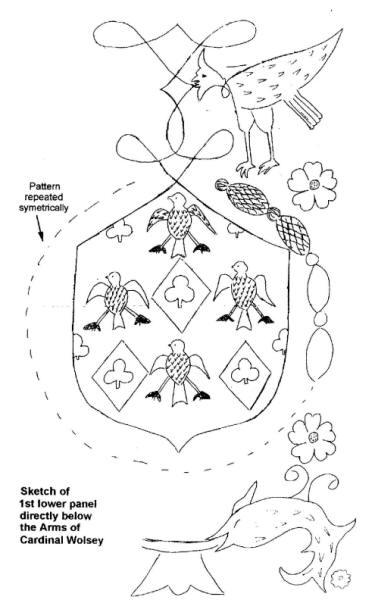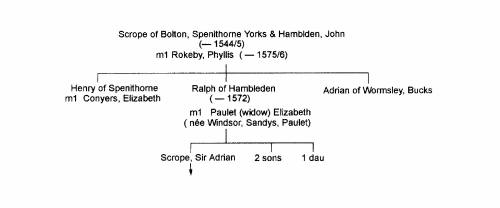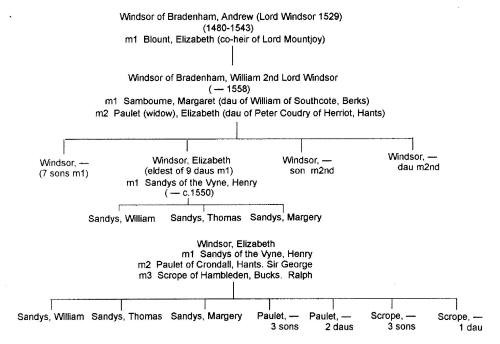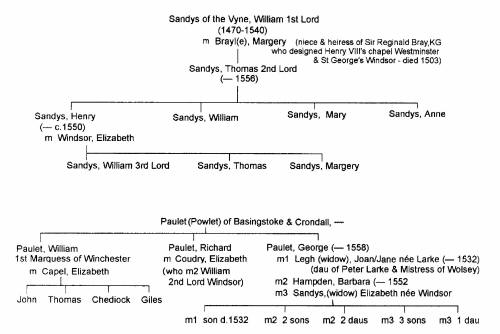Hambleden |
The Wolsey Altar |
|||||||||||||||
|
Introduction On Chiltern Slopes The Wolsey Altar Tithe Map 1845 November 4, 1828 A Curious Which hunt The Hambleden Magazine |
[ This piece was written by Joan Barksfield after
painstaking research over a number of years and was first
published in the Journal of the Henley Archaeological &
Historical Group in Autumn 2003 ]
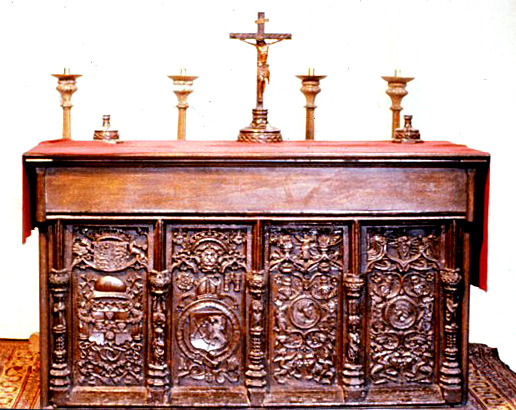 The aims of the following pages are twofold, firstly to establish how the Wolsey Altar came to its final resting place in Hambleden Church and secondly to try and find out where this piece originated. In the south transept of Hambleden Church there stands a beautiful piece of early Tudor carving, now known as the Wolsey Altar. The altar was constructed by Nichols and James of High Wycombe in 1959-60 from an elaborately carved screen/bedscreen/bedhead. Previously the screen had been attached to a vestry cupboard standing in the tower of the church. The cupboard became worm eaten so the Parochial Church Council decided that the screen must be detached from it and put to another use in order to preserve it. Following the account of the screen written by Rev Stanton, Rector 1896-1924, the impression was that this screen was the head and foot of a bedstead mounted one above the other, and known as the Wolsey Bedstead. 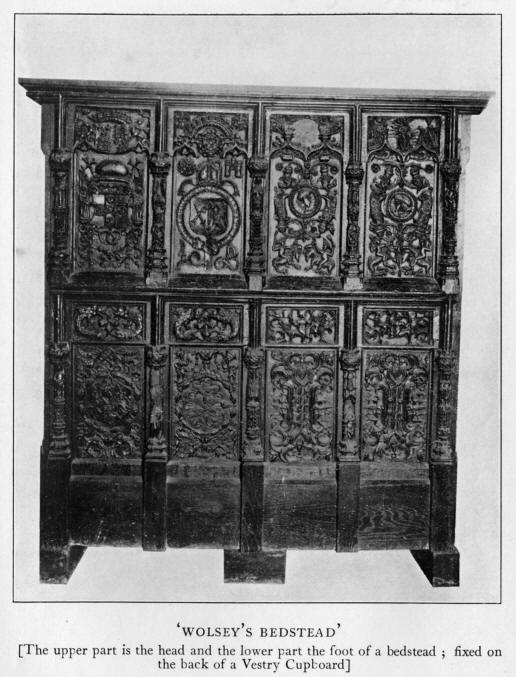 It was decided to separate the head and the foot and make of it a free standing Nave Altar, with the head on one side and the foot on the other. However when it was examined by experts at Nichols and James it was discovered that the screen had never been in two pieces, and that it was probably an early Tudor bedscreen placed at the head of, or attached to the head of a bed. The decision having been taken to construct an altar the piece was cut in two horizontally. With hindsight and from a historian's point of view this was an unfortunate decision. The altar has proved too heavy to be moved frequently so it now stands in the south transept where it is difficult to see the back, the lower carved portion of the original screen. When used to back the Vestry cupboard, the screen was about five feet wide and six feet high. Incorporated were two rows of four carved panels set one above the other, each measuring roughly one foot by two feet. From left to right the upper row of panels contain: 1. The arms of Thomas Wolsey surmounted by a Cardinal's hat, and above these again the Royal arms with supporters (greyhound & dragon). 2. The arms of Richard Foxe, (Bishop of Winchester, Lord Privy Seal to Henry VIII & founder of Corpus Christi College, Oxford) encircled by the Garter Motto. On the left is the Tudor rose and on the right the Triple crowned Castle of Castile. A scroll below the arms carries the Bishop's motto 'Est Deo Gratia' with a bursting pomegranate to the right of it and a pomegranate flower (?) to the left.  Panels 1 and 2
Panels 1 and 23. The encircled portrait of a man supported on either side by stylised creatures (possibly dolphins). Above (missing from the illustration but since found and replaced) is a representation of Christ in Glory. Below the portrait are two men brandishing cudgels and riding on human headed beasts. 4. Is very like 3 but above this man's portrait is a representation of the Virgin and Child. From left to right the lower row of panels contain: 5. A pseudo 'coat of arms' that has been described as 'semee of eaglets and trefoils slipped on lozenges'.
7 & 8 are almost identical and would appear to be just fanciful carving. In the small panel above each is a man carrying a sword in one hand and a pennon (?) in the other whilst riding on a human headed horse. The pillars on either side and between these eight panels are decorated with carving of biblical figures, saints or angels (?) Some are mutilated but whether by design or accident is not known. The possible origin of the Wolsey bedscreen In Mr J C Fox's description of the Wolsey screen he says 'that it seems not improbable that it was part of the furniture of the Vyne at Basingstoke'. Rev A H Stanton in his book adds some extra local findings and upholds much of Fox’s article strengthened by the opinion of a Mr Muirhead who had lived in Hambleden but 'who knew the Vyne intimately'. A footnote in the Victoria County History of Buckinghamshire quotes Rev Stanton as the source of its information as to the origin of the Wolsey screen. A description of the Wolsey Altar in the Hambleden Church Guide and recent publications of books, guides etc. mentioning Hambleden all quote the above as to the screen's origin. The Vyne at Basingstoke was the residence of the Sandys family and both Fox and Stanton suggest that Elizabeth née Windsor/Sandys/Paulet/Scrope brought the bedscreen with her from the Vyne to Hambleden. (Scrope her last husband held the Manor of Hambleden.) Stanton adds that the screen may have been purchased by the Rev W H Ridley, Rector 1840-82 either at the sale of the Old Bishop's Palace at Fingest or at the sale of Lord Cardigan's effects at the Manor House, Hambleden. Wolsey was Bishop of Lincoln for a short while in 1514 and is said to have visited Fingest. Hambleden was then in the Diocese of Lincoln. Mr Fox wrote ‘local tradition says that the carving once formed part of Cardinal Wolsey's bedstead'. He goes on to examine the theory that the bedscreen might have come from Fingest to Hambleden but then discredits this as the place of origin as 'Wolsey was Bishop of Lincoln for less than a year in 1514 and was not made Cardinal until 1518'. The palace at Fingest was long gone before Ridley's time. Following the line of enquiry that the screen was purchased from the Manor House, a word of explanation is necessary about the Earls of Cardigan. In a letter to his intended wife in 1808 Rev Ridley mentions the 6th Earl of Cardigan as living at the Manor House and refers to him as Mr Brudenell. (Thomas Brudenell the 7th Earl - who led the charge of the Light Brigade - was born in the Manor House and was baptised in the font at Hambleden in 1797.) The Earls of Cardigan were not owners of the Hambleden Manor House but tenants of the Lord of the Manor, the Scott-Murray family. If indeed the screen came from a sale at the Manor House, this was most likely to have been in 1815, for in that year the Brudenells moved to Deene Park and were succeeded in residence at Hambleden by Charles Scott-Murray. So far a search for an 1815 sales catalogue has proved elusive, either from the Cardigan Papers at Deene Park or from the Public Record Office at Northampton. The suggestion that Rev W H Ridley purchased the screen can be dismissed as the Henley Guide printed by Hickman and Stapleden in 1826 gives a description of the Wolsey screen in Hambleden Church at that date. However Rev H C Ridley, father of W H, and Rector of Hambleden 1804-32 would have been the most likely purchaser. So far the reference in the Henley Guide is the earliest written evidence of the Wolsey screen. Searches of Hambleden Church records, of inventories and faculties in Lincoln, of Oxford Diocesan records and the Public Record Office at Aylesbury have produced no mention of the Wolsey screen prior to 1826. Mr Fox suggested that Elizabeth Windsor/Sandys/Paulet/Scrope presented the screen to the church, but this seems unlikely in view of the absence of reference to it. That she brought the screen with her on her marriage into the Scrope family and left it in the Manor House on her death in 1601/2 seems the most likely explanation. The Manor House at Hambleden appears to have been tenanted rather than lived in by the Lords of the Manor during most of the 17th to 19th centuries, which might explain why a piece of Tudor furniture remained there through the years from the time of Elizabeth’s third marriage.
The Scropes of Bolton had been Lords of the Manor of Hambleden from the mid 15th C and their relatives lived at the Manor House at least from 1489 when Ralph Scrope became Rector. The first Manor House is the property now named Kenricks, the present 'new' Manor House was built by Emmanuel Scrope in 1603. Described below are two memorials in the church showing connections with Elizabeth née Windsor. On the south wall of the tower is a memorial to Raffe Scrope, brother to the Lord of the Manor bearing this inscription :
The inscription across the top of the Sandys memorial 'Liberame Domine de morte aeterna' [ Deliver me Oh Lord from eternal death ] comes from the old Latin Burial service. Here are the words below:
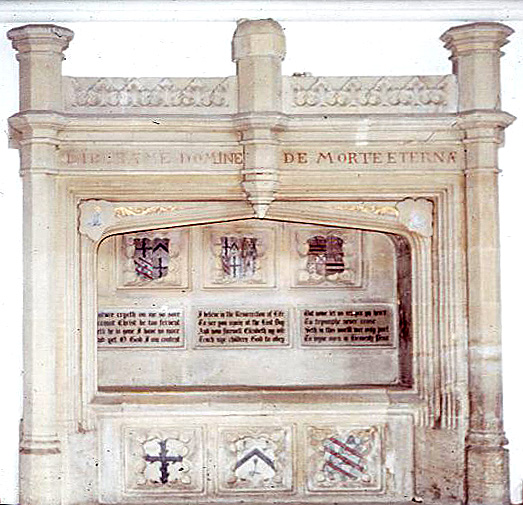 The Elizabeth referred to in both memorials was born Elizabeth Windsor, daughter of William 2nd Lord Windsor of Bradenham and Margaret heiress of William Samborne of Southcote, Berks. Elizabeth was one of sixteen children having seven brothers and eight younger sisters. Lipscomb in his section on Bradenham says 'Sir William Windsor was one of the Knights of the Bath at the coronation of Queen Anne Boleyn. He was Sheriff of Bucks in the 29th year of Henry VIII and an early supporter of Queen Mary. He built the Manor House at Bradenham with the chapel and made the burial ground adjacent … He died in 1558 and was buried with great pomp at Bradenham'.
Elizabeth was married first to Henry Sandys, son of Thomas Sandys and grandson of William Sandys of the Vyne. Elizabeth and Henry had three children William, Thomas and Margery. Eventually William became 3rd Baron Sandys as his father Henry predeceased Thomas, little is known about Henry and not much more about Thomas. Henry's grandfather William was a well known figure in Henry VIII's time, the king thought highly of him and visited the Vyne on at least three occasions in 1510, 1531and 1535, accompanied by Anne Boleyn. During the 1531 visit an entry was recorded in the King's Household Accounts 'To one who brought a screen to the Vyne from Pexhalles House -40s'. Stanton remarked on this entry 'Perhaps this is the very screen!' The Hampshire Victoria History states that Henry VIII visited Beaurepaire in August 1531 when Ralph Pexall owned it. This manor adjoined the Vyne. Ralph Pexall was a relation by marriage to the Brocas' and distantly to the Sandys. Whenever Tudor monarchs went visiting they took a large retinue with them, and it was quite usual for hosts entertaining the king to borrow furniture for the occasion, especially beds, tables and benches, so there is nothing very remarkable about the entry in the King's Accounts and nothing to connect it to the Hambleden screen. William Sandys was made a Knight of the Garter in 1518, he was a statesman and soldier, and involved in various expeditions to Spain and France, accompanying Thomas Wolsey on some of them. The arms and devices of Cardinal Wolsey are to be seen in the carved woodwork of the Vyne. In 1526 William Sandys became Lord Chamberlain. The Dictionary of National Biography says of him 'He went with the tide in religious matters, though there were not wanting signs that he was of the Old Way of Thinking'. When Sandys first set about improving the Vyne he beautified the chapel with the addition of carved woodwork. The arms of Sandys together with those of the Paulet family, Richard Foxe and others appear in the parish church of Basingstoke, St Michael the Archangel. The nave is believed to have been rebuilt under the auspices of Richard Foxe and doubtless the Paulets, Sandys and others were subscribers. The most important edifice to which Lord Sandys was the chief subscriber was built in conjunction with Bishop Foxe, the now ruined chapel of the Holy Ghost; which according to Baigent and Millard 'stands in the ancient cemetery of Linten on the north side of the Town' (Basingstoke). In 1525 Henry VIII granted a charter to establish a fraternity there. William Sandys was entombed in this chapel in 1542. ‘Some image or other object of more than ordinary devotion representing the Holy Ghost stood in this chapel’. A full description of the chapel is to be found in the Hampshire Victoria County History. The preceding paragraphs show that William Sandys was closely connected to both Wolsey and Foxe.
When William Sandys altered and beautified the Vyne, he had the Oak Gallery panelled from floor to ceiling with rows of linenfold panels interspersed with the arms, crests, badges and initials of his family, friends and associates. These include Henry VIII and Katharine of Aragon, Wolsey, Foxe, Tunstall Bishop of London, Warham Archbishop of Canterbury, Sandys, Bray, Brocus, DeVere, Sir William Essex, Foster, Hungerford, Neville, Paulet, Power, Manners and others, as well as fanciful devices and carved heads of men and women. The panelling was probably fitted after 1515 when Wolsey was made Cardinal and before 1528 when Bishop Foxe died and Wolsey was losing favour. This would appear to establish the date of the Hambleden screen for the same reasons. The carvings on the Wolsey screen bear a striking resemblance to those in the Oak Gallery and the oak chimney piece now in the Tapestry room (the Chute family arms were inserted later). Mr Muirhead drew the illustrations for Chaloner Chute's book 'A History of the Vyne' and it was his opinion that the Hambleden screen came from the Vyne via Elizabeth Windsor's marriages. However this style of carving was by no means only to be found at the Vyne, both Henry VIII and Wolsey favoured Italian workers and artists in wood and stone; courtiers and noblemen strove to emulate the work to be found in the king's palaces. Mr W R D Harrison who having made a detailed study of all the carvings at the Vyne and produced an informed and scholarly catalogue of the woodwork in the Oak Gallery says, 'In my view, for what it is worth, there is nothing heraldic or stylistic to suggest that the Wolsey bedhead originated from the Vyne. If it did there would almost certainly be a Sandys' shield on it. I would expect the key to it to lie in the 'shield' below Wolsey's shield on the bedhead. I have tried to identify it but cannot. Apart from the mystery ‘shield’ I would have expected the bedhead to have originated from Hampton Court or one of Wolsey's other palaces, perhaps it was one of the spoils of his downfall, merely being retained as a souvenir at its last location'. Chaloner Chute states that an Inventory of furnishings etc. at the Vyne was made in 1541 (after Sir William's death) and was left by his daughter in law and executrix, Thomas Sandys wife, with her father Lord Roos. Lord Roos was the ancestor of the Duke of Rutland and the inventory was found among papers at Belvoir Castle in 1888. Chute says of the Vyne 'the principal reception rooms were at that time, used as sleeping chambers for important guests, and contained magnificent bedsteads'. Unfortunately an examination of a full copy of the 1541 inventory, now in the Winchester Records Office, neither proved nor disproved the existence of the Wolsey bedstead at the Vyne, as the descriptions of the beds are not detailed enough, but some of them do mention carving. In the Tudor period daughters were often married off with more consideration for their marriage portions and prospects than their feelings in the matter. In the case of Elizabeth Windsor, she could have been genuinely grieved by the death of Henry as, after another two marriages, she set up a memorial to him at Hambleden. Beds were among the most important articles of furniture in Tudor household and the marriage bed was usually considered to be the property of the widow, so is it beyond the bounds of possibility that Elizabeth would take with her, as part of her dower settlement, a very handsome bed when she left the Vyne for Crondall in about 1552, and again when she married for the third time and moved to Hambleden in about 1559. Crondall There is one other slight possibility for the origin or circuitous history of the Wolsey bedhead, and this concerns a Crondall-Wolsey connection. When Thomas Wolsey was a young man he was 'uncanonically married' to Joanne Larke, daughter of Peter Larke 'gentleman of Huntingdonshire and Citizen of London', and by her had two children a son and daughter. Later Joane Larke was legally married to George Legh of Adlington in Cheshire. Records show that Wolsey kept in touch with the Legh family. George Legh died on 12th June 1529 and his widow Joane was soon married to George Paulet of Crondall in Basingstoke Hundred. Joane, née Larke, bore George Paulet two children, but died shortly afterwards. George Paulet married secondly Barbara Hampden and thirdly Elizabeth relict of Henry Sandys. Was the Wolsey bedhead already at Crondall? Perhaps the pseudo 'coat of arms' should be read as 'semee of larks and trefoils on lozenges'. Perhaps Wolsey had the bedhead carved for Joan Larke and devised spurious arms for her, since her father probably was not of sufficient rank to have any. Maybe it was Joan who brought the bedhead with her when she became wife to George Paulet, whose third wife was Elizabeth, née Windsor. So far there is no evidence for this, it is merely speculation both on the coincidence of her name and the birds on the pseudo 'coat of arms'. Conclusion It would appear most likely that it was Rev H C Ridley Rector of Hambleden who purchased the Wolsey screen at the sale of effects at the Manor House Hambleden in 1815 and had it placed in Hambleden Church. That the screen had been part of the furniture of Hambleden manor house since Elizabeth brought it with her from Crondall (where it was already?) or from the Vyne when she left as Henry Sandys' widow seems a feasible explanation. How the Wolsey bedhead came to be at the Vyne, Crondall or elsewhere is unclear. The bedhead seems very likely to have belonged to or been commissioned by Cardinal Wolsey at some time, or maybe made for his use by one of his associates (or perhaps Wolsey had it made for Joane Larke?) Is the fifth panel a rebus and does it hold the key to the origin of this elaborate piece of carving? That the Hambleden Wolsey altar/screen/bedhead has survived through nearly five centuries in almost perfect condition is a miracle in itself, and certainly there is evidence to its having formed the headpiece of a magnificent bedstead for the use of important guests. Addendum In his will Richard Fox left one bed to William Sandys and another to William Paulet ‘as specified in the Inventory'. Unfortunately, so far, this Inventory has not been traced so there is no way of telling if either of the bequeathed beds had the bedhead described and pictured here. (Information re-will from Winchester Cathedral) |

